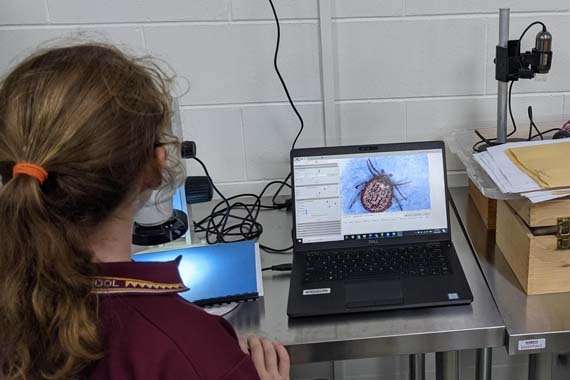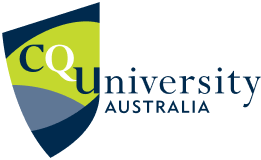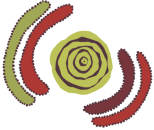Description
Parasites in the Wild is a citizen science project that engages rural students in collecting and identifying ticks, particularly the elusive kangaroo tick (Amblyomma triguttatum) from farmland and community spaces in the Central Highlands region.
Partners
The Outback Exploratorium, Emerald, Queensland
Impact
The Parasites in the Wild project will contribute to resolving the taxonomic doubt around four subspecies of the tick and to identify strategies for effective citizen science approaches, particularly in rural and regional areas and with primary-school-aged children.
Saba Sinai and Dr Amy Cosby
The presence of the elusive kangaroo tick (Amblyomma triguttatum) is being brought into light in the Central Highlands, thanks to a partnership between CQUniversity researchers, the Outback Exploratorium and dedicated 'citizen scientists' from the local community.
Led by CQUni Agriculture lecturer Saba Sinai and Research Fellow Dr Amy Cosby, the Parasites in the Wild project involves collecting and identifying ticks from farmland and community spaces in the Central Highlands region.
'Despite its name, the ornate kangaroo tick, Amblyomma triguttatum, feeds on a range of domestic animals and livestock. Amblyomma triguttatum has four described subspecies, but there is some doubt on the taxonomic validity of these subspecies,' says Saba.
'Resolving this doubt requires tick collection at the zones of contact where two or more subspecies meet. Luckily for us, one of only three apparent zones of contact between these subspecies is located in the Central Highlands Region, which includes towns like Emerald, Blackwater, Springsure, Duaringa, and Sapphire.'
Funded by more than $26 000 from the Office of the Queensland Chief Scientist and in-kind contributions from CQUniversity and the Outback Exploratorium, Parasites in the Wild also aims to foster an admiration of science in the community.
Saba says the project team has been working with primary producers, kangaroo harvesters, interested community members and primary school-aged children to collect ticks.
The field collection is largely from the Central Highlands region, but some enthusiastic citizen scientists from beyond the region have also supplied samples, demonstrating the level of enthusiasm and eagerness that members of the public have for scientific research.
Primary school students predominantly engaged with the 'Science Squad' at the Outback Exploratorium, a local not-for-profit science education centre based in Emerald, are a key group of participants in the project.
'In addition to seeking to resolve the taxonomic uncertainty looming over these subspecies, the project also hopes to investigate the impact that participation in citizen science projects have on primary-school-aged children and other community members,' Saba explains.
'The research also helps to reveal features of effective science engagement in rural and regional areas. By demonstrating the unique role that such communities can play in scientific research by collecting samples around them, it is hoped people will develop an interest and aspiration for further study and career endeavours in science.'
The project is currently in its second stage, which focuses on identifying the collected specimens to the subspecies level and analysing the qualitative data from surveys and interviews of participants.
'Populations of adult Amblyomma triguttatum, which are the easiest to identify to subspecies level, tend to taper off at the end of summer/beginning of autumn,' says Saba.
'We are also analysing and describing the artistic works of the Science Squad participants that they produced during two weeks of sci-art workshops with Dr Anita Milroy. We will hold one or two more workshops for livestock producers again before the end of the project.'
Queensland Chief Scientist Professor Hugh Possingham recently visited Emerald to see the progress of the project. Flying scientists Dr Anita Milroy, who is also on the Parasites in the Wild team and University of Queensland's Dr Christina Zdenek, held a special session for the Science Squad participants at the Outback Exploratorium.
'The Science Squad kids relished the opportunity to speak to the Chief Scientist about their work with Parasites in the Wild,' says Saba.
'The citizen scientists, whether they are livestock producers, kangaroo harvesters, pet owners or Science Squad students and their parents, have all contributed to the project through tick collection but also through participating in qualitative research which sheds more light on citizen science projects that embrace all age groups in rural and regional communities.
'The citizen scientists have also made interesting observations, particularly about animal behaviour related to tick parasitism. This could provide the basis for further research, an unforeseen outcome from this project.'
While the data is still being collated and assessed Saba says one finding was that one subspecies, Amblyomma triguttatum queenslandensis, seems to be found in the Central Highlands, whereas previously only Amblyomma triguttatum triguttatum and Amblyomma triguttatum ornatissimum were reported in the region.
'We hope to make a contribution to resolving the taxonomic doubt around these four subspecies and to identify strategies for effective citizen science approaches, particularly in rural and regional areas and with respect to primary-school aged children.'
Connect with CQUniversity
At CQUniversity we know the value of our connections locally and around the world. Our partnerships help us create opportunities, deliver solutions and change lives. From time to time, we share our Connections Count update where we share our highlights, including research impact stories like the ones below. Sign up to become one of our valued connections.



